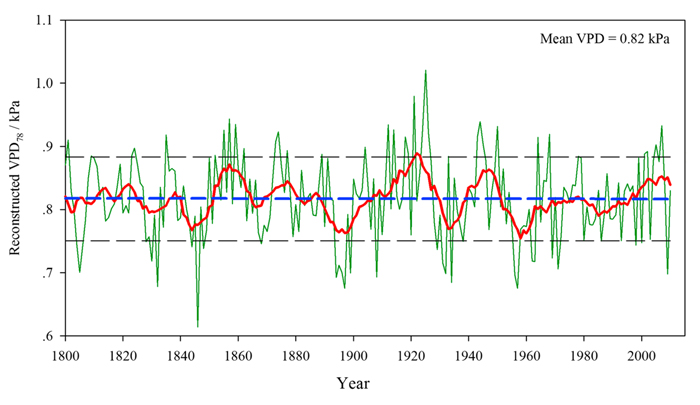| Follow @co2science |
Paper Reviewed
Liu, X., Zhang, X., Zhao, L., Xu, G., Wang, L., Sun, W., Zhang, Q., Wang, W., Zeng, X. and Wu, G. 2017. Tree ring δ18O reveals no long-term change of atmospheric water demand since 1800 in the northern Great Hinggan Mountains, China. Journal of Geophysical Research: Atmospheres 122: 6697-6712.
Introducing their work, Lui et al. (2017) note that "climatic warming is expected to significantly increase the atmospheric water demand (driven by the vapor-pressure deficit (VPD)) in the future (Williams et al., 2013), thereby increasing the intensity of drought in forest ecosystems (Restaino et al. (2016). When VPD is high, plants lose water at a faster rate to the atmosphere via transpiration unless they close their stomata to conserve water. Thus, changes in VPD can influence the flow of water through ecosystems, which can thereby impact the carbon cycle. Consequently, it is important to expand our knowledge of long-term changes in VPD to enhance our understanding of ecosystem water and carbon dynamics. Unfortunately, few historical VPD datasets exist; and proxy records are therefore needed to infer long-term trends. And in this regard, Liu et al. write that to the best of their knowledge, "no long-term VPD reconstruction has been published." And they thus set out to become the first research team to reconstruct and publish such a record.
To accomplish their objective, the ten scientists sampled tree rings from dominant Dahurian larch (Larix gmelinii) and Mongolian pine (Pinus sylvestris var. mongolica) from the boreal forest permafrost region of northeastern China, in order to create a "robust VPD reconstruction since 1800 to present for the study region." This they did believing that the increasing temperature throughout the study region would increase the reconstructed VPD record.
Liu et al.'s VPD proxy is presented in Figure 1 below. With regard to this record, the authors say they "found no overall long-term increasing or decreasing trend for VPD since 1800, suggesting that despite the increasing temperatures and thawing permafrost throughout the region, forest transpirational demand has not increased significantly during the past two centuries." What is more, they note that "VPD did not limit growth of larch and pine, even during extreme drought years."
These combined findings thus indicate that climate warming has not impacted the VPD, as the authors had initially hypothesized; nor has it led to postulated drought-induced reductions in boreal forest growth. Now that is extremely good news well worth reporting!

Figure 1. Changes in the reconstructed July-August vapor pressure deficit (VPD) since 1800. The solid red line is the smoothed curve with an 11-year moving window analysis for the reconstructed VPD. The horizontal dashed blue line is the linear fit for the reconstructed VPD; the regression for this line was not significant. The horizontal dashed black lines represent one standard deviation from the mean VPD. Source: Liu et al. (2017).
References
Restaino, C.M., Peterson, D.L. and Littell, J. 2016. Increased water deficit decreases Douglas fir growth throughout western US forests. Proceeding of the National Academy of Sciences, USA 113: 9557-9562.
Williams, A.P., Allen, C.D., Macalady, A.K., Griffin, D., Woodhouse, C.A., Meko, D.M., Swetnam, T.W., Rauscher, S.A., Seager, R., Grissino-Mayer, H.D., Dean, J.S., Cook, E.R., Gangodagamage, C., Cai, M. and McDowell, N.G. 2013. Temperature as a potent driver of regional forest drought stress and tree mortality. Nature Climate Change 3: 292-297.
Posted 18 December 2017



